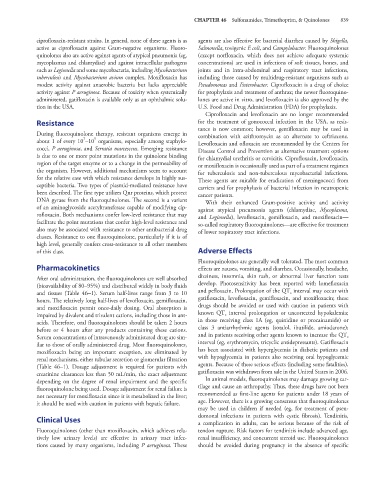Page 853 - Basic _ Clinical Pharmacology ( PDFDrive )
P. 853
CHAPTER 46 Sulfonamides, Trimethoprim, & Quinolones 839
ciprofloxacin-resistant strains. In general, none of these agents is as agents are also effective for bacterial diarrhea caused by Shigella,
active as ciprofloxacin against Gram-negative organisms. Fluoro- Salmonella, toxigenic E coli, and Campylobacter. Fluoroquinolones
quinolones also are active against agents of atypical pneumonia (eg, (except norfloxacin, which does not achieve adequate systemic
mycoplasmas and chlamydiae) and against intracellular pathogens concentrations) are used in infections of soft tissues, bones, and
such as Legionella and some mycobacteria, including Mycobacterium joints and in intra-abdominal and respiratory tract infections,
tuberculosis and Mycobacterium avium complex. Moxifloxacin has including those caused by multidrug-resistant organisms such as
modest activity against anaerobic bacteria but lacks appreciable Pseudomonas and Enterobacter. Ciprofloxacin is a drug of choice
activity against P aeruginosa. Because of toxicity when systemically for prophylaxis and treatment of anthrax; the newer fluoroquino-
administered, gatifloxacin is available only as an ophthalmic solu- lones are active in vitro, and levofloxacin is also approved by the
tion in the USA. U.S. Food and Drug Administration (FDA) for prophylaxis.
Ciprofloxacin and levofloxacin are no longer recommended
Resistance for the treatment of gonococcal infection in the USA, as resis-
tance is now common; however, gemifloxacin may be used in
During fluoroquinolone therapy, resistant organisms emerge in combination with azithromycin as an alternate to ceftriaxone.
7
9
about 1 of every 10 –10 organisms, especially among staphylo- Levofloxacin and ofloxacin are recommended by the Centers for
cocci, P aeruginosa, and Serratia marcescens. Emerging resistance Disease Control and Prevention as alternative treatment options
is due to one or more point mutations in the quinolone binding for chlamydial urethritis or cervicitis. Ciprofloxacin, levofloxacin,
region of the target enzyme or to a change in the permeability of or moxifloxacin is occasionally used as part of a treatment regimen
the organism. However, additional mechanisms seem to account for tuberculosis and non-tuberculous mycobacterial infections.
for the relative ease with which resistance develops in highly sus- These agents are suitable for eradication of meningococci from
ceptible bacteria. Two types of plasmid-mediated resistance have carriers and for prophylaxis of bacterial infection in neutropenic
been described. The first type utilizes Qnr proteins, which protect cancer patients.
DNA gyrase from the fluoroquinolones. The second is a variant With their enhanced Gram-positive activity and activity
of an aminoglycoside acetyltransferase capable of modifying cip- against atypical pneumonia agents (chlamydiae, Mycoplasma,
rofloxacin. Both mechanisms confer low-level resistance that may and Legionella), levofloxacin, gemifloxacin, and moxifloxacin—
facilitate the point mutations that confer high-level resistance and so-called respiratory fluoroquinolones—are effective for treatment
also may be associated with resistance to other antibacterial drug of lower respiratory tract infections.
classes. Resistance to one fluoroquinolone, particularly if it is of
high level, generally confers cross-resistance to all other members
of this class. Adverse Effects
Fluoroquinolones are generally well tolerated. The most common
Pharmacokinetics effects are nausea, vomiting, and diarrhea. Occasionally, headache,
After oral administration, the fluoroquinolones are well absorbed dizziness, insomnia, skin rash, or abnormal liver function tests
(bioavailability of 80–95%) and distributed widely in body fluids develop. Photosensitivity has been reported with lomefloxacin
and tissues (Table 46–1). Serum half-lives range from 3 to 10 and pefloxacin. Prolongation of the QT interval may occur with
c
hours. The relatively long half-lives of levofloxacin, gemifloxacin, gatifloxacin, levofloxacin, gemifloxacin, and moxifloxacin; these
and moxifloxacin permit once-daily dosing. Oral absorption is drugs should be avoided or used with caution in patients with
impaired by divalent and trivalent cations, including those in ant- known QT interval prolongation or uncorrected hypokalemia;
c
acids. Therefore, oral fluoroquinolones should be taken 2 hours in those receiving class 1A (eg, quinidine or procainamide) or
before or 4 hours after any products containing these cations. class 3 antiarrhythmic agents (sotalol, ibutilide, amiodarone);
Serum concentrations of intravenously administered drug are sim- and in patients receiving other agents known to increase the QT
c
ilar to those of orally administered drug. Most fluoroquinolones, interval (eg, erythromycin, tricyclic antidepressants). Gatifloxacin
moxifloxacin being an important exception, are eliminated by has been associated with hyperglycemia in diabetic patients and
renal mechanisms, either tubular secretion or glomerular filtration with hypoglycemia in patients also receiving oral hypoglycemic
(Table 46–1). Dosage adjustment is required for patients with agents. Because of these serious effects (including some fatalities),
creatinine clearances less than 50 mL/min, the exact adjustment gatifloxacin was withdrawn from sale in the United States in 2006.
depending on the degree of renal impairment and the specific In animal models, fluoroquinolones may damage growing car-
fluoroquinolone being used. Dosage adjustment for renal failure is tilage and cause an arthropathy. Thus, these drugs have not been
not necessary for moxifloxacin since it is metabolized in the liver; recommended as first-line agents for patients under 18 years of
it should be used with caution in patients with hepatic failure. age. However, there is a growing consensus that fluoroquinolones
may be used in children if needed (eg, for treatment of pseu-
Clinical Uses domonal infections in patients with cystic fibrosis). Tendinitis,
a complication in adults, can be serious because of the risk of
Fluoroquinolones (other than moxifloxacin, which achieves rela- tendon rupture. Risk factors for tendinitis include advanced age,
tively low urinary levels) are effective in urinary tract infec- renal insufficiency, and concurrent steroid use. Fluoroquinolones
tions caused by many organisms, including P aeruginosa. These should be avoided during pregnancy in the absence of specific

